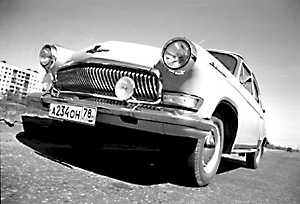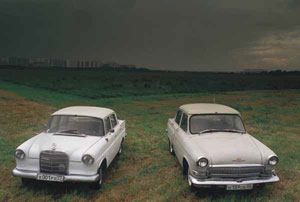Test drive GAZ 21 Volga 1956 - 1970 Sedan
Ultraviolet
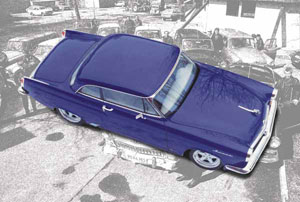
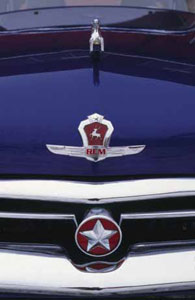 Everything was nice! In the morning - the anthem of the Soviet Union. Every five years - the Congress. Thrashed everybody in hockey, fighting for the harvest, given the quality of five-year labor warranty. Minimum stimuli. About dandruff, caries and critical days in general, no one knew anything. Not to mention the hot delivery. The beauty of stagnation ...
Everything was nice! In the morning - the anthem of the Soviet Union. Every five years - the Congress. Thrashed everybody in hockey, fighting for the harvest, given the quality of five-year labor warranty. Minimum stimuli. About dandruff, caries and critical days in general, no one knew anything. Not to mention the hot delivery. The beauty of stagnation ... Not so today. Critical days have become the norm. Across the country, the hair falls out and broken teeth. Circle pad and soulful neuyuta. No anthem.
Rock-n-roll is dead. But the hot rods - there! For two years, as there was a first - our Russian!
So now all experiencing turmoil often. Pleasant and unpleasant. The latter, of course, more often. For this same judge of any meeting with a similar technique - usually a shock. Pleasant.
The firm EL Motors showed us her coupe built as soon as it has completed the final debugging and imposed last marafet.
First look - and a long pause. Stupor. What's happening? We have to believe that this is the Volga. Volga is! In what turned her eyes do not tear ...: cool glitter purple body, glazed look headlights, chrome shining ice - the creeps! Yes, this is the most beautiful of all the apparatus that we have seen in the past year.
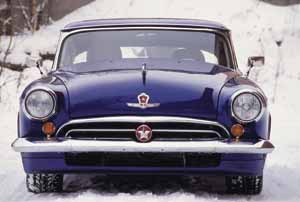 Technics
Technics First there was a blue BMW M3. Almost new. On the run! According to her last saw, otchirknuv roof, doors and fenders.
Then began the search for a suitable Volga. Volga needed the 1957-1958 model years, as subsequently front of the car was different. Such cars were produced in all 30 thousand, and everyone understood that the time spared by a negligible number of them. Therefore, let the knife could only be irrevocably dead. In 1996, the most miserable Volga with the star was found and bought for $ 2,000.
Thus began building hot rod BMW M3 + GAS 21. In the terminology, hot rods with bodies of vehicles produced after 1949 are known as street cars (street machine). By EL Motors company terminology, RCM means Road, Coupe, Moscow.
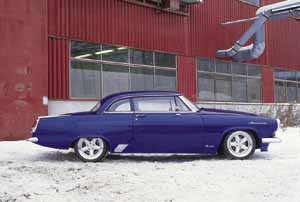 Technology
Technology RCM is a visual manual on the topic: how to make not just hot-genus, but a beautiful car. And for this, of course, we need beautiful technological solutions. It took a year to create this unique product from two different-caliber cars. The carrier body has no additional subframes and auxiliary frame. To give greater stiffness only spars and roof racks were reinforced.
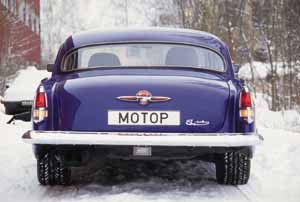 The BMW M3 platform remains unchanged. Moreover, the mutual arrangement of the power unit, suspension, engine shield, pedal block, steering column, doorway, and front armchairs are no longer affected. This is the most important solution in this machine, which is advantageous of it from other hot childbirth, where separate discreet units with many adapters and adapters are collected on a re-weld frame. It is also technological and more reliable here - there is a modern chassis that does not need to be refined, which is trimmed with nostalgic iron and chrome.
The BMW M3 platform remains unchanged. Moreover, the mutual arrangement of the power unit, suspension, engine shield, pedal block, steering column, doorway, and front armchairs are no longer affected. This is the most important solution in this machine, which is advantageous of it from other hot childbirth, where separate discreet units with many adapters and adapters are collected on a re-weld frame. It is also technological and more reliable here - there is a modern chassis that does not need to be refined, which is trimmed with nostalgic iron and chrome. From BMW only cut the roof racks and all outdoor panels. Thus, the power structure of the body below the roof was saved, and the panels from the 21st were sewed to its remnants. It makes sense to trace the main stages of this sewing on metal.
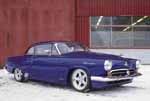 The fact that under the hood of the Volga can be shoved by the compact row six BMW, it is clear to everyone. Only this time they did the opposite - the Volgsky hood and the wings covered the 280-strong engine.
The fact that under the hood of the Volga can be shoved by the compact row six BMW, it is clear to everyone. Only this time they did the opposite - the Volgsky hood and the wings covered the 280-strong engine.  The upper contour of the Volgov front wings was supposed to lie on the BMW hood line. To link the lower edges of the wings with the platform, while retaining the ground clearance, they were cut. And so that the wheels can turn to the previous degree, not touching the wings, they increased the arches and re-made flashes. The front wings of the Volga compared to BEEMW have a larger overhang, but the smaller distance from the wheel arch to the doorway.
The upper contour of the Volgov front wings was supposed to lie on the BMW hood line. To link the lower edges of the wings with the platform, while retaining the ground clearance, they were cut. And so that the wheels can turn to the previous degree, not touching the wings, they increased the arches and re-made flashes. The front wings of the Volga compared to BEEMW have a larger overhang, but the smaller distance from the wheel arch to the doorway. In addition, the Volga has a straight vertical door contour, and BMW is curvilinear. To dock the front wings with the doorway, they had to lengthen. At the same time, the BMW was left not only to the doorway, but also the internal panels (frame) doors with locks and power windows.
Hood. Binding to the terrain was carried out on both sides. The front part had to conjugate the wings and profile of the wings, the rear was hung on the BMW motor compartment shield. Therefore, the hood was lengthening, respectively, the wings and the extended rear part were brought directly to the roofs of the roofs (in the present Volga, the hood ends not at the racks, but at the engine compartment shield).
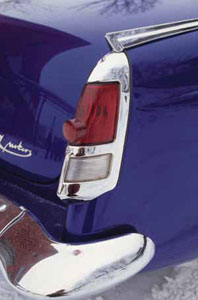 The rear Volgo wings were at the level of BMW samplers. Vertical is increasingly or less clear - the bottom of the wing is cut. But from the arrangement of the rear wing horizontally, the swiftness of the image of hot-kind depended. There will be a small geometric explanation.
The rear Volgo wings were at the level of BMW samplers. Vertical is increasingly or less clear - the bottom of the wing is cut. But from the arrangement of the rear wing horizontally, the swiftness of the image of hot-kind depended. There will be a small geometric explanation. 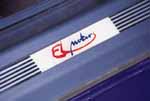 The fact is that through the rear wing passes the Volgovskaya firewall (zipper stroke), starting with the headlight rim on the front wing and cutting the entire sidewall 21st to the rear lights. The stroke composite center is located on the rear door and has the shape of the bandwidth. The part of the strip, which comes from the top of the angle down, the left side goes into the ground in the spack of the rear wheel contact with the road, right - too, but already strictly by tangent to the wheel. All this can be represented as a group of geometric shapes consisting of a circle (wheel), an equilateral triangle (part of the rear door, limited by a strip) and a rhombus (chrome decorative plate on the lower edge of the lane flowing into the ground).
The fact is that through the rear wing passes the Volgovskaya firewall (zipper stroke), starting with the headlight rim on the front wing and cutting the entire sidewall 21st to the rear lights. The stroke composite center is located on the rear door and has the shape of the bandwidth. The part of the strip, which comes from the top of the angle down, the left side goes into the ground in the spack of the rear wheel contact with the road, right - too, but already strictly by tangent to the wheel. All this can be represented as a group of geometric shapes consisting of a circle (wheel), an equilateral triangle (part of the rear door, limited by a strip) and a rhombus (chrome decorative plate on the lower edge of the lane flowing into the ground). 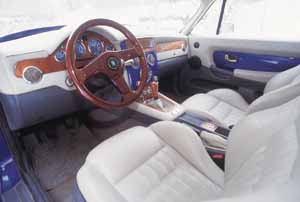 The 21st is considered one of the most beautiful machines of its time largely due to the original and correctly sustained body composition.
The 21st is considered one of the most beautiful machines of its time largely due to the original and correctly sustained body composition. what that before the creators of the coupe, there was a task not to disturb her (despite the fact that it was not possible to save the Volgsky proportions of the bottom of the body and the roof). And on which direction the lines will be shut-off, the image of the machine as a whole was dependent.
It was found simple and, perhaps, the only correct composite solution: imaginary straight, dividing the above corner in half should pass through the rear wheel center. At the same time, the upper edge of the chrome-plated rhombic (the only remaining detail of the lower tier of the Volga side decor) is also at the level of this center. Thus, the coordinates of the rear wings relative to the wheels and the base of the car were determined.
As already mentioned, the length of the doors and the openness of the BMW M3 remained unchanged. All door fittings - too. For the outdoor cladding of each of them, three fragments of the doors of the 21st doors - one from the back and two from the front.
The lid of the trunk is elongated by analogy with the hood, and the arches of the rear wheels were changed and, like in front, raised.
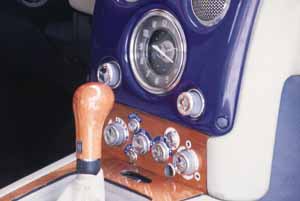 When comparing the size hot rod sedan and may be some confusion. Machines in 1957 and 1959 model years were 4830 mm long. This is the car was also used in the construction of the coupe RCM. Since 1962, the GAZ-21 is shorter by 50 mm - due to the abolition of massive fangs at the front and rear bumpers. Masters EL Motors used bumpers from the model 1962. Therefore, the calculation of the length of a compartment reliably maintain the number 4780. Hot Rod turned by 30 mm long Volga. Of these, 10 went on to mm wheelbase (2710 mm at the BMW M3 against 2700 mm in the sedan), the remaining 20 mm - at the rear overhang.
When comparing the size hot rod sedan and may be some confusion. Machines in 1957 and 1959 model years were 4830 mm long. This is the car was also used in the construction of the coupe RCM. Since 1962, the GAZ-21 is shorter by 50 mm - due to the abolition of massive fangs at the front and rear bumpers. Masters EL Motors used bumpers from the model 1962. Therefore, the calculation of the length of a compartment reliably maintain the number 4780. Hot Rod turned by 30 mm long Volga. Of these, 10 went on to mm wheelbase (2710 mm at the BMW M3 against 2700 mm in the sedan), the remaining 20 mm - at the rear overhang. The width of the hot rod remained volgovskih - 1800 mm at the corners of the bumpers. Height - 1340 mm. It is 280 mm smaller than the Volga, including 140 mm - by shortening the racks (height-pillar coupe - 260 mm against 400 mm for the sedan).
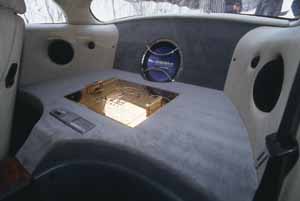 On the one hand, the desire to make clear hot rod as low as possible. Necessary. On the other - the lowered roof must not interfere with visibility and comfort.
On the one hand, the desire to make clear hot rod as low as possible. Necessary. On the other - the lowered roof must not interfere with visibility and comfort. coupe creators decided that the height of 1340 mm is the most suitable for him. The number is actually taken from the ceiling ... 1340 mm - the height of the ceiling BMW M3. The height of the compartment RCM equal to the height of the car-carrier units! That is, when the same as in the BMW, seating arrangements and essential controls - steering, pedal box and the box lever - landing of the driver is automatically turned ergonomic - a hair's breadth, as in M-third.
The height of the roof depends on the angle of inclination of the transverse struts. It must be consistent with the kinematics of windows - provide continuous and dense sliding side window. In this case, the slope was only possible minimum. Therefore, there is a need to expand the roof.
Normal volgovskih was raspolovinit and extended insert fragment.
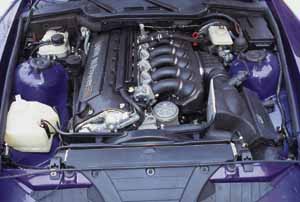 Horizontally, she was put up so that the drainage groove on the back of the rack to visually drop-down in the center of the rear wheel. It once again stressed the compositional perfection body coupe (the effect was enhanced by a chrome strip in the groove).
Horizontally, she was put up so that the drainage groove on the back of the rack to visually drop-down in the center of the rear wheel. It once again stressed the compositional perfection body coupe (the effect was enhanced by a chrome strip in the groove). Windshield frame and its chrome cladding - fragmentary volgovskih. The glass itself is manufactured specifically for this machine. It is served by three janitor. A third, optional, has its own electric motor.
Doors without window frames. Instead of bent side windows, BMW are applied flat, with inclined rails from the Volga. At the same time, the German windows mechanism and the electric motor are also inclined. With the button by pressing the button on the door handle, the glass is lowered by several millimeters, released from the P-shaped seal. When closing the door, after the lock mechanism is triggered, it rises back to the seal.
 The salon is not so radical as the exterior and, as you expect from hot-kind. Everything is very calm. The obsessive presence of BMW (skin, wood) does not fully feel the charm of our main machine 60. Only huge watches remained from the Volga. Such religious objects, like a tube receiver and a semicircular speedometer, disappeared. However, it is not so important if you see the back of the deer running away from you through the windshield.
The salon is not so radical as the exterior and, as you expect from hot-kind. Everything is very calm. The obsessive presence of BMW (skin, wood) does not fully feel the charm of our main machine 60. Only huge watches remained from the Volga. Such religious objects, like a tube receiver and a semicircular speedometer, disappeared. However, it is not so important if you see the back of the deer running away from you through the windshield. Circumstances did not allow us to roll back RCM. But we will definitely do this with our test pilot at the first opportunity. I really want.
And last. The country should know its hot rates by name. Mikhail and Dmitry Petrenko, Semen Ivanov, Denis Panfil, Yuri Chernenko, Edward Reutman - did this car.
See you!
A source: Magazine Motor [№2 / 1998]



